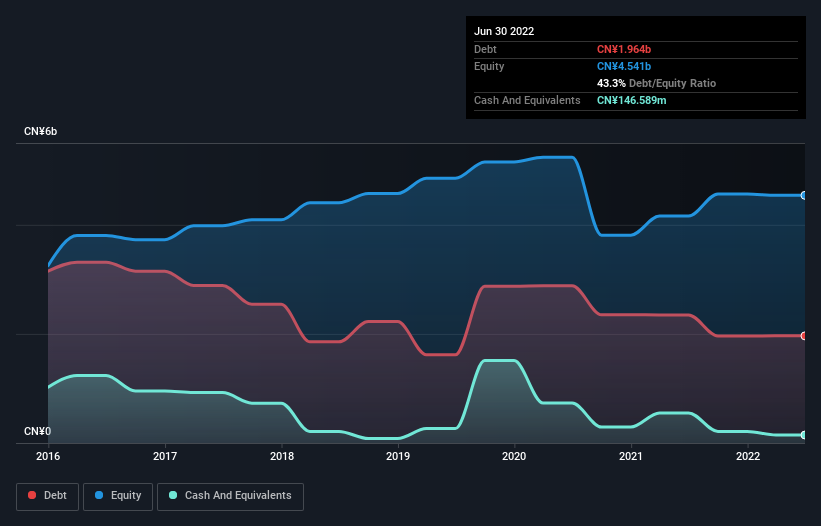- Hong Kong
- /
- Infrastructure
- /
- SEHK:357
Does Hainan Meilan International Airport (HKG:357) Have A Healthy Balance Sheet?

The external fund manager backed by Berkshire Hathaway's Charlie Munger, Li Lu, makes no bones about it when he says 'The biggest investment risk is not the volatility of prices, but whether you will suffer a permanent loss of capital.' When we think about how risky a company is, we always like to look at its use of debt, since debt overload can lead to ruin. Importantly, Hainan Meilan International Airport Company Limited (HKG:357) does carry debt. But is this debt a concern to shareholders?
Why Does Debt Bring Risk?
Debt is a tool to help businesses grow, but if a business is incapable of paying off its lenders, then it exists at their mercy. In the worst case scenario, a company can go bankrupt if it cannot pay its creditors. However, a more frequent (but still costly) occurrence is where a company must issue shares at bargain-basement prices, permanently diluting shareholders, just to shore up its balance sheet. Of course, the upside of debt is that it often represents cheap capital, especially when it replaces dilution in a company with the ability to reinvest at high rates of return. When we examine debt levels, we first consider both cash and debt levels, together.
Check out our latest analysis for Hainan Meilan International Airport
What Is Hainan Meilan International Airport's Debt?
You can click the graphic below for the historical numbers, but it shows that Hainan Meilan International Airport had CN¥1.96b of debt in June 2022, down from CN¥2.35b, one year before. However, it also had CN¥146.6m in cash, and so its net debt is CN¥1.82b.

A Look At Hainan Meilan International Airport's Liabilities
The latest balance sheet data shows that Hainan Meilan International Airport had liabilities of CN¥6.09b due within a year, and liabilities of CN¥209.5m falling due after that. Offsetting these obligations, it had cash of CN¥146.6m as well as receivables valued at CN¥318.3m due within 12 months. So it has liabilities totalling CN¥5.83b more than its cash and near-term receivables, combined.
This is a mountain of leverage relative to its market capitalization of CN¥9.62b. This suggests shareholders would be heavily diluted if the company needed to shore up its balance sheet in a hurry.
In order to size up a company's debt relative to its earnings, we calculate its net debt divided by its earnings before interest, tax, depreciation, and amortization (EBITDA) and its earnings before interest and tax (EBIT) divided by its interest expense (its interest cover). The advantage of this approach is that we take into account both the absolute quantum of debt (with net debt to EBITDA) and the actual interest expenses associated with that debt (with its interest cover ratio).
Hainan Meilan International Airport has a debt to EBITDA ratio of 4.1 and its EBIT covered its interest expense 5.9 times. This suggests that while the debt levels are significant, we'd stop short of calling them problematic. Shareholders should be aware that Hainan Meilan International Airport's EBIT was down 74% last year. If that earnings trend continues then paying off its debt will be about as easy as herding cats on to a roller coaster. The balance sheet is clearly the area to focus on when you are analysing debt. But it is future earnings, more than anything, that will determine Hainan Meilan International Airport's ability to maintain a healthy balance sheet going forward. So if you're focused on the future you can check out this free report showing analyst profit forecasts.
Finally, a business needs free cash flow to pay off debt; accounting profits just don't cut it. So the logical step is to look at the proportion of that EBIT that is matched by actual free cash flow. Over the last three years, Hainan Meilan International Airport saw substantial negative free cash flow, in total. While that may be a result of expenditure for growth, it does make the debt far more risky.
Our View
To be frank both Hainan Meilan International Airport's conversion of EBIT to free cash flow and its track record of (not) growing its EBIT make us rather uncomfortable with its debt levels. But at least its interest cover is not so bad. We should also note that Infrastructure industry companies like Hainan Meilan International Airport commonly do use debt without problems. Overall, it seems to us that Hainan Meilan International Airport's balance sheet is really quite a risk to the business. For this reason we're pretty cautious about the stock, and we think shareholders should keep a close eye on its liquidity. The balance sheet is clearly the area to focus on when you are analysing debt. But ultimately, every company can contain risks that exist outside of the balance sheet. For example, we've discovered 1 warning sign for Hainan Meilan International Airport that you should be aware of before investing here.
If you're interested in investing in businesses that can grow profits without the burden of debt, then check out this free list of growing businesses that have net cash on the balance sheet.
Valuation is complex, but we're here to simplify it.
Discover if Hainan Meilan International Airport might be undervalued or overvalued with our detailed analysis, featuring fair value estimates, potential risks, dividends, insider trades, and its financial condition.
Access Free AnalysisHave feedback on this article? Concerned about the content? Get in touch with us directly. Alternatively, email editorial-team (at) simplywallst.com.
This article by Simply Wall St is general in nature. We provide commentary based on historical data and analyst forecasts only using an unbiased methodology and our articles are not intended to be financial advice. It does not constitute a recommendation to buy or sell any stock, and does not take account of your objectives, or your financial situation. We aim to bring you long-term focused analysis driven by fundamental data. Note that our analysis may not factor in the latest price-sensitive company announcements or qualitative material. Simply Wall St has no position in any stocks mentioned.
About SEHK:357
Hainan Meilan International Airport
Engages in the aeronautical and non-aeronautical businesses at the Haikou Meilan Airport in the People's Republic of China.
Reasonable growth potential and fair value.
Market Insights
Community Narratives




